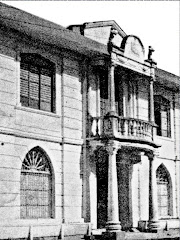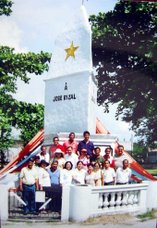DPS CLASS 67: History of Daet
DPS CLASS 67: History of Daet
The "Trece de Abril Cry" of
Daet, Camarines Norte
Our view of the 1896 Philippine Revolution remains "Manila-centric. The symbols, the heroes and the big events we celebrate of this historic era continue to be focused on Central and Southern Luzon. Rarely does one get an idea about the 1896 Philippine Revolution in the provinces.
The people of Daet, Camarines Norte, made two historic "firsts" insofar as the Philippines Revolution was concerned. They erected the first Dr. Jose Rizal Monument in the Philippines on December 30, 1897. They launched the first "Cry" of the Philippine Revolution in Kabicolan on April 13, 1897.
 Many Bicolanos in Manila joined the Katipunan when Andres Bonifacio and others found the society on July 7, 1892. Led by Ildefonso Moreno, a crew member of the merchant ship Taal that plied the Manila-Bicol route, these intrepid Bicolano Katipuneros planted the Katipunan ideals in Camarines Norte and neighboring Bicol towns.
Many Bicolanos in Manila joined the Katipunan when Andres Bonifacio and others found the society on July 7, 1892. Led by Ildefonso Moreno, a crew member of the merchant ship Taal that plied the Manila-Bicol route, these intrepid Bicolano Katipuneros planted the Katipunan ideals in Camarines Norte and neighboring Bicol towns.
On April 13, 1897. amidst shouts of "Ngayon Na ang Ora (Now is the Time)," Moreno led the Katipuneros from the towns of Labo, Talisay, Daet, and Calasgasan. They attacked the Spaniards in Daet, the capital town of Camarines Norte. The battle lasted the whole day. The timely arrival of reinforcements from Nueva Caceres enabled the Spaniards to counter-attack and crush the Moreno-led Katipunan uprising.
 Harsh retributions followed. Various accounts mention that more than 500 inhabitants in Camarines Norte, led by Ildefonso Moreno, were executed by a tribunal de cuchillo (military court). The colonial government's success, however, was short-lived. The successes of the revolution in Southern and Central Luzon led the colonial authorities to abandon the Bicol region. In September, 1898, the entire Bicol region erupted in arms against Spanish rule. By the end of the month, The Bicol region was in Filipino hands.
Harsh retributions followed. Various accounts mention that more than 500 inhabitants in Camarines Norte, led by Ildefonso Moreno, were executed by a tribunal de cuchillo (military court). The colonial government's success, however, was short-lived. The successes of the revolution in Southern and Central Luzon led the colonial authorities to abandon the Bicol region. In September, 1898, the entire Bicol region erupted in arms against Spanish rule. By the end of the month, The Bicol region was in Filipino hands.
As we commemorate the "Trece de Abril" of Daet, Camarines Norte, we honor the Bicolano hero Ildefonso Moreno and the rest of his compatriots. Because the people of the Bicol region and the other places in the country actively participated in the struggle to recover Philippine freedom, the Philippine revolution of 1896 finally succeeded in ending the centuries of Spanish colonial rule.
The "Trece de Abril Cry" of
Daet, Camarines Norte
Our view of the 1896 Philippine Revolution remains "Manila-centric. The symbols, the heroes and the big events we celebrate of this historic era continue to be focused on Central and Southern Luzon. Rarely does one get an idea about the 1896 Philippine Revolution in the provinces.
The people of Daet, Camarines Norte, made two historic "firsts" insofar as the Philippines Revolution was concerned. They erected the first Dr. Jose Rizal Monument in the Philippines on December 30, 1897. They launched the first "Cry" of the Philippine Revolution in Kabicolan on April 13, 1897.
 Many Bicolanos in Manila joined the Katipunan when Andres Bonifacio and others found the society on July 7, 1892. Led by Ildefonso Moreno, a crew member of the merchant ship Taal that plied the Manila-Bicol route, these intrepid Bicolano Katipuneros planted the Katipunan ideals in Camarines Norte and neighboring Bicol towns.
Many Bicolanos in Manila joined the Katipunan when Andres Bonifacio and others found the society on July 7, 1892. Led by Ildefonso Moreno, a crew member of the merchant ship Taal that plied the Manila-Bicol route, these intrepid Bicolano Katipuneros planted the Katipunan ideals in Camarines Norte and neighboring Bicol towns.On April 13, 1897. amidst shouts of "Ngayon Na ang Ora (Now is the Time)," Moreno led the Katipuneros from the towns of Labo, Talisay, Daet, and Calasgasan. They attacked the Spaniards in Daet, the capital town of Camarines Norte. The battle lasted the whole day. The timely arrival of reinforcements from Nueva Caceres enabled the Spaniards to counter-attack and crush the Moreno-led Katipunan uprising.
 Harsh retributions followed. Various accounts mention that more than 500 inhabitants in Camarines Norte, led by Ildefonso Moreno, were executed by a tribunal de cuchillo (military court). The colonial government's success, however, was short-lived. The successes of the revolution in Southern and Central Luzon led the colonial authorities to abandon the Bicol region. In September, 1898, the entire Bicol region erupted in arms against Spanish rule. By the end of the month, The Bicol region was in Filipino hands.
Harsh retributions followed. Various accounts mention that more than 500 inhabitants in Camarines Norte, led by Ildefonso Moreno, were executed by a tribunal de cuchillo (military court). The colonial government's success, however, was short-lived. The successes of the revolution in Southern and Central Luzon led the colonial authorities to abandon the Bicol region. In September, 1898, the entire Bicol region erupted in arms against Spanish rule. By the end of the month, The Bicol region was in Filipino hands.As we commemorate the "Trece de Abril" of Daet, Camarines Norte, we honor the Bicolano hero Ildefonso Moreno and the rest of his compatriots. Because the people of the Bicol region and the other places in the country actively participated in the struggle to recover Philippine freedom, the Philippine revolution of 1896 finally succeeded in ending the centuries of Spanish colonial rule.



3 comments:
thanks Men for this contribution. Lahi ng insan Danny mo si Ildefonso Moreno. I'll do additional research on Daet so I can have more facts when I feature this article in our blogsite.
Your own mini-reunion there is forthcoming, I hope you'll get a good attendance and that you'll have lots of fun.
I have a lot of new things to post in our blogsite, but I'm quite busy these days, I'm not complaining though becausing I'm enjoying my work. I'm setting up a computerized monitoring system for a small consortium of NGOs, and I'm also developing its blogsite. I have to read a lot about poverty, good governance, transparency, and accountability at the local level (barangay/barrio and municipal), study the consortium's present Monitoring and Evaluation (M&E) system, and visit project sites to detemine appropriate indicators and manner of capturing data based on local capabilities. I have to review also my programming skills. While relaxing, I'm developing our (NGO's) blogsite. I'll be travelling to Negros Occidental again next week (Aug 22-24).
Best wishes to you and Rene. I hope, tuloy-tuloy na paggaling niya with lots of TLC from you.
Toti
Hi! I am Richard Moreno from Albay and my surname is from Pangasinan but according to my tita, she heard stories about our ancestors who were Katipuneros in Camarines Norte. Saan po ba ang roots ng Morenos dito sa Pilipinas? Thanks! :)
I am the great grandson of Ildefonso. Very proud of my Bicol family
Post a Comment